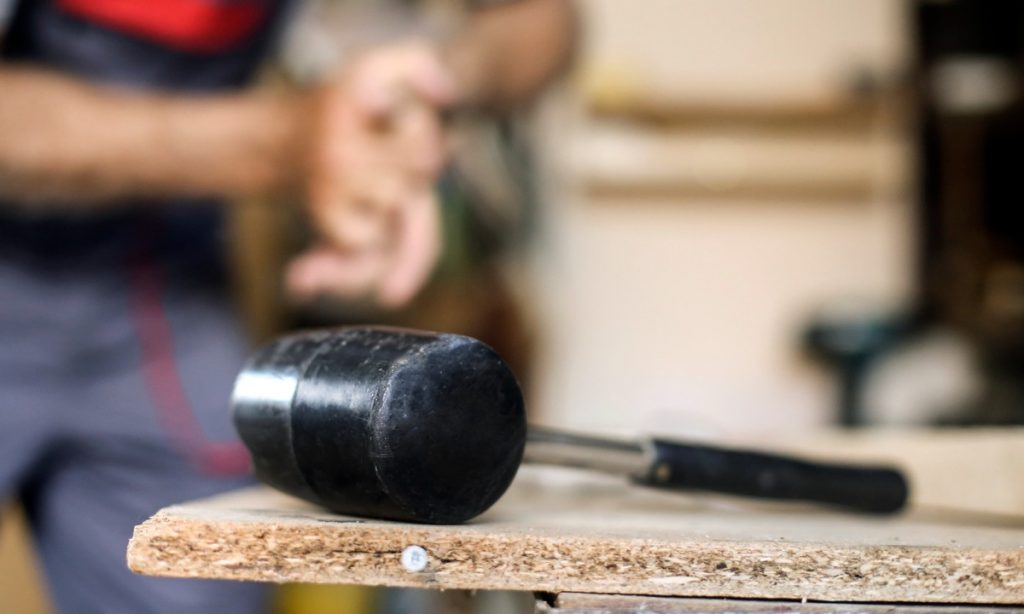Rubber Mallet Vs. Wooden Mallet: When to Use Which

Almost everybody knows what a mallet is — a picture of a standard metal hammer probably comes to your mind whenever you hear the word. What is it good for? To punch nails in the walls, on ceilings, in the wood, and wherever you need to make strikes of great force, and that’s pretty much the extent of it.
So, what do you do if you need a mallet to deliver gentler thumps? You can’t rely on a metal-faced mallet (it usually has a metal face and a wooden/metal handle). This type of mallet was designed to pierce, shatter, and bring forth destruction. What you need is something that can exert light to moderate force.
What’s a Rubber Mallet?
A rubber mallet has a wooden, metallic, or fiber handle but with a rubber face. Now, the rubber face could either be a solid rubber head attached to a handle or a thick rubber pad that covers the metallic head underneath. This categorization also sums up the two types of rubber mallets available out there: a solid rubber mallet or one that encases a metallic head underneath.
Uses of a Rubber Mallet
- To gently thump and level tiles, panels, and carpets during installation on walls and floors
- Can be used as a sounding device on walls and floors
- Used when installing pavers and bricks — helps minimize the human effort required to fit them into their place
- Can be used to close plastic lids where there’s a chance of breakage otherwise
Are There Any Cons to Using Rubber Mallets?
Rubber mallets have a crazy bounce, and it’s part of the reason why they sometimes aren’t completely made out of solid rubber. So, it’s essential that you buy a mallet that is not too bouncy. If you do, make sure you practice the required precautions to avoid injuries. As a general rule, remember that if your rubber mallet has more weight, it’ll help reduce the mallet’s bounce-back.
You’ll find mallets in a range of weights, from 8 to 32 ounces. An ideal fit would be in the 12 to 16 ounce range. Also, if you aren’t careful with the weight/impact of a mallet, it may leave marks where you don’t want it to.
What’s a Wooden Mallet?
One may confuse the term wooden mallet with a mallet that has a wooden handle. Since their names are based on the material of the mallet’s head, a wooden mallet is essentially a mallet with a wooden head.
It could have a handle made out of another material but since attaching a wooden head to another material is troublesome from a manufacturing perspective, wooden mallets are usually completely made out of wood.
Using a Wooden Mallet: Pros and Cons
Wooden mallets deliver a sharper blow as compared to rubber mallets, which makes them rank somewhere in the middle of metallic and rubber mallets. They’re used in woodworking when there’s a need to assemble joints or when hammering chisels and dowels.
A rubber mallet is not an appropriate choice in this case because it has an increased bounce that only makes using it fatiguing in the process. Metal hammer faces can damage the wood in a blink so they’re never a viable option.
A disadvantage to buying a wooden mallet? It has a limited usage which mostly surrounds woodworking and carpentry.
Summing up With a Breakdown of the Different Types of Mallets
There primarily are three types of mallets; rubber mallets, wooden mallets, and your standard metal hammers. They’re categorized based on their usage and that’s because all three of them deliver a unique force that’s only good for particular applications. There also are brass mallets with a round head — they provide excellent force and control in tight quarters. There’s also a dead blow mallet that has a reduced bounce and helps in assembly; its rubber head is usually filled with pellets that absorb the impact energy.
